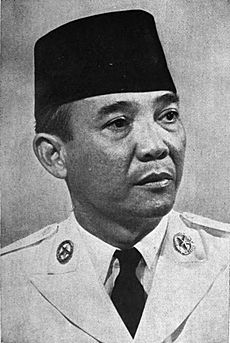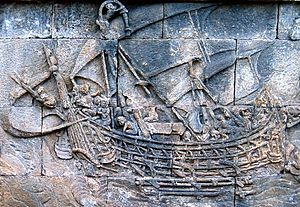History of Indonesia facts for kids
The history of Indonesia is very old. Indonesia is a country in Southeast Asia with 17,508 islands. Its story goes back to Homo erectus, also known as "Java Man." Scientists have found fossils of these early humans that are about one million years old.
Most modern Indonesians are Austronesian people. They came to Southeast Asia from Taiwan around 2000 BC. The native Melanesian people moved to the far eastern parts of Indonesia. The land was great for farming. When people learned to grow wet-field rice around 800 BC, villages and towns grew. Small kingdoms started to appear by the first century CE. Indonesia's location on sea trade routes was very important. Trade with India and China had already been happening for hundreds of years. This trade has always been a big part of Indonesia's history.

Contents
Ancient Kingdoms and New Religions
Rise of Srivijaya and Majapahit
From the 600s CE, the strong Srivijaya kingdom grew powerful because of trade. This kingdom was based on the sea. With trade, new religions like Hinduism and Buddhism came to Indonesia. Later, in the late 1200s, the Hindu Majapahit kingdom started in eastern Java. Under a leader named Gajah Mada, its power spread across much of Indonesia. Many people call this time a "Golden Age" for Indonesia.
Islam Spreads Across the Islands
During the 1200s, Islam began to spread in northern Sumatra. More and more parts of Indonesia slowly became Muslim. By the end of the 1500s, Islam was the main religion in Java and Sumatra. However, it often mixed with the local cultures and beliefs that were already there.
European Traders Arrive
Seeking Spices and Control
The first Europeans arrived in Indonesia in 1512. These were Portuguese traders led by Francisco Serrão. They wanted to control the valuable spices like nutmeg, cloves, and cubeb pepper from the Maluku Islands. After the Portuguese, Dutch and British traders also came.
The Dutch East India Company
In 1602, the Dutch created the Dutch East India Company (VOC). This company became the most powerful European group in Indonesia. However, the Dutch did not control all of Indonesia right away. It took until the early 1900s for their control to reach the borders of what Indonesia is today.

Independence and New Leadership
World War II and Freedom
During World War II, the Dutch lost control of Indonesia. In August 1945, Sukarno, a very important nationalist leader, declared Indonesia's independence. He became the first president. After some fighting, the Netherlands officially recognized Indonesia's independence in December 1949. Only Western New Guinea remained under Dutch control for a while longer.
From Democracy to New Order
Sukarno slowly moved Indonesia away from democracy and towards a dictatorship. But he lost power to the head of the military, General Suharto. Suharto officially became president in March 1968. The US government supported him. He encouraged other countries to invest money in Indonesia. This helped the economy grow for the next thirty years. However, his rule also involved corruption and stopping people from speaking against him.
Modern Indonesia
Economic Crisis and Change
In 1997 and 1998, Indonesia was hit very hard by the Asian Financial Crisis. This made many people unhappy with Suharto's government. Large protests happened. Suharto resigned on May 21, 1998. In 1999, East Timor voted to become independent from Indonesia. This happened after Indonesia had controlled it for twenty-five years.
Steps Towards Democracy
After Suharto left power, Indonesia became more democratic. A program was started to give more power to local regions. The first direct presidential election happened in 2004. Even with these changes, some political and economic problems remained. In 2005, a peace agreement was reached to end a conflict in Aceh.
Images for kids
-
Example of Rice Terraces in Indonesia.
-
1600-year-old stone inscription from the era of Purnawarman, king of Tarumanagara, founded in Tugu sub-district of Jakarta.
-
8th century Borobudur Buddhist monument, Sailendra dynasty, it is the largest Buddhist temple in the world.
-
Prambanan in Java was built during the Sanjaya dynasty of Mataram Kingdom, it is one of the largest Hindu temple complexes in Southeast Asia.
-
Sewu temple in Special Region of Yogyakarta.
-
Batavian (Jakarta) tea factory in the 1860s.
-
Japanese bicycle infantry move through Java during their occupation of the Dutch East Indies
-
Sukarno speaking at the Rapat Akbar (grand meeting) on 19 September 1945.
-
Suharto was the military president of Indonesia from 1967 to 1998.
See also
 In Spanish: Historia de Indonesia para niños
In Spanish: Historia de Indonesia para niños























